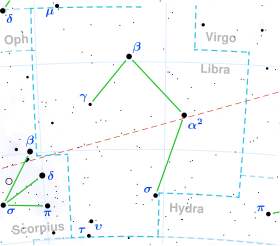| Observation data Epoch J2000.0 Equinox J2000.0 | |
|---|---|
| Constellation | Libra |
| α1 Lib | |
| Right ascension | 14h 50m 41.18097s[1] |
| Declination | −15° 59′ 50.0482″[1] |
| Apparent magnitude (V) | +5.153[2] |
| α2 Lib | |
| Right ascension | 14h 50m 52.71309s[1] |
| Declination | −16° 02′ 30.3955″[1] |
| Apparent magnitude (V) | +2.741[2] |
| Characteristics | |
| α1 Lib | |
| Spectral type | F3 V[3] |
| U−B color index | −0.02[4] |
| B−V color index | +0.39[4] |
| α2 Lib | |
| Spectral type | kA2hA5mA4 IV-V[5] |
| U−B color index | +0.10[4] |
| B−V color index | +0.15[4] |
| Astrometry | |
| α1 Lib | |
| Radial velocity (Rv) | −23.47[6] km/s |
| Proper motion (μ) | RA: −136.27[1] mas/yr Dec.: −59.04[1] mas/yr |
| Parallax (π) | 43.52 ± 0.43 mas[1] |
| Distance | 74.9 ± 0.7 ly (23.0 ± 0.2 pc) |
| Absolute magnitude (MV) | +3.35[7] |
| α2 Lib | |
| Proper motion (μ) | RA: −105.68[1] mas/yr Dec.: −68.40[1] mas/yr |
| Parallax (π) | 43.03 ± 0.19 mas[1] |
| Distance | 75.8 ± 0.3 ly (23.2 ± 0.1 pc) |
| Orbit[6] | |
| Period (P) | 70.34 days |
| Semi-major axis (a) | 0.51 au |
| Eccentricity (e) | 0.41 |
| Semi-amplitude (K2) (secondary) | 43.1 km/s |
| Details | |
| α1 Lib | |
| Mass | 1.4–1.5/0.5–0.6[8] M☉ |
| Radius | 1.409[9][a] R☉ |
| Surface gravity (log g) | 4.25[5] cgs |
| Temperature | 6,653[7] K |
| Metallicity [Fe/H] | −0.07[7] dex |
| Rotational velocity (v sin i) | 5.95[10] km/s |
| Age | 1.1+0.6 −0.8[7] Gyr |
| α2 Lib | |
| Mass | 1.95 / 1.79[11] M☉ |
| Radius | 2.21 / 1.92[11] R☉ |
| Surface gravity (log g) | 3.91[5] cgs |
| Temperature | 8,200 / 7,930[11] K |
| Metallicity [Fe/H] | −0.24[5] dex |
| Other designations | |
Zubenelgenubi, Kiffa Australis, Lanx Australis, α Lib. | |
| α1 Lib: 8 Librae, BD−15 3965, FK5 1387, HD 130819, HIP 72603, HR 5530, SAO 158836.[12] | |
| α2 Lib: 9 Librae, BD−15 3966, FK5 548, HD 130841, HIP 72622, HR 5531, SAO 158840.[13] | |
| Database references | |
| SIMBAD | α Lib |
| α1 Lib | |
| α2 Lib | |
Alpha Librae (α Librae, abbreviated Alpha Lib, α Lib) is a double star and, despite its 'alpha' designation, it is the second-brightest star system (or star) in the constellation of Libra. The two components are designated α1 Librae and α2 Librae. The system bore the traditional name of Zubenelgenubi /zuːˌbɛnɛldʒɪˈnuːbi/,[14] though the International Astronomical Union now regards that name as only applying to α2 Librae.[15]
Alpha2 Librae is 0.33 degrees north of the ecliptic so it can be occulted by the Moon and (very rarely) by planets. It was occulted by Venus on October 25, 1947;[16] the next occultation by a planet will be by Mercury on 10 November 2052.[17] Both components are eclipsed (occulted) by the sun from about 7–9 November.[18] Thus the star can be viewed the whole night, crossing the sky, in early May.
- ^ a b c d e f g h i j Cite error: The named reference
aaa474_2_653was invoked but never defined (see the help page). - ^ a b Cite error: The named reference
sps1966was invoked but never defined (see the help page). - ^ Cite error: The named reference
mkwas invoked but never defined (see the help page). - ^ a b c d Mermilliod, J.-C. (1986). "Compilation of Eggen's UBV data, transformed to UBV (unpublished)". Catalogue of Eggen's UBV Data. Bibcode:1986EgUBV........0M.
- ^ a b c d Cite error: The named reference
apj132_1_161was invoked but never defined (see the help page). - ^ a b Cite error: The named reference
orbitwas invoked but never defined (see the help page). - ^ a b c d Cite error: The named reference
aaa501_3_941was invoked but never defined (see the help page). - ^ Cite error: The named reference
aaa514_A98was invoked but never defined (see the help page). - ^ Cite error: The named reference
cruzalebeswas invoked but never defined (see the help page). - ^ Cite error: The named reference
aaa520_A79was invoked but never defined (see the help page). - ^ a b c Cite error: The named reference
waisbergwas invoked but never defined (see the help page). - ^ Cite error: The named reference
SIMBAD1was invoked but never defined (see the help page). - ^ Cite error: The named reference
SIMBAD2was invoked but never defined (see the help page). - ^ Kunitzsch, Paul; Smart, Tim (2006). A Dictionary of Modern star Names: A Short Guide to 254 Star Names and Their Derivations (2nd rev. ed.). Cambridge, Massachusetts: Sky Pub. ISBN 978-1-931559-44-7.
- ^ "IAU Catalog of Star Names". Retrieved 28 July 2016.
- ^ Cite error: The named reference
Koennen1981was invoked but never defined (see the help page). - ^ Peuschel, Marco (2003). "Astronomische Ereignisse der besonderen Art" Archived 2005-03-16 at the Wayback Machine. Retrieved July 10, 2005.
- ^ In the Sky Earth astronomy reference utility showing the ecliptic and relevant date as at J2000 - present
Cite error: There are <ref group=lower-alpha> tags or {{efn}} templates on this page, but the references will not show without a {{reflist|group=lower-alpha}} template or {{notelist}} template (see the help page).
